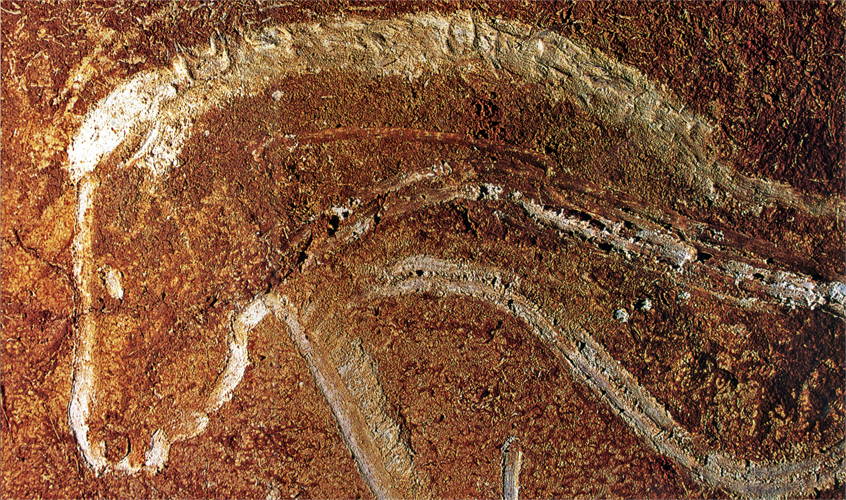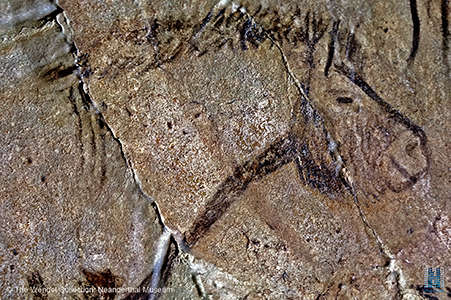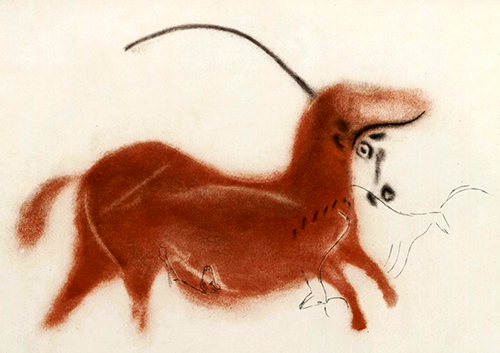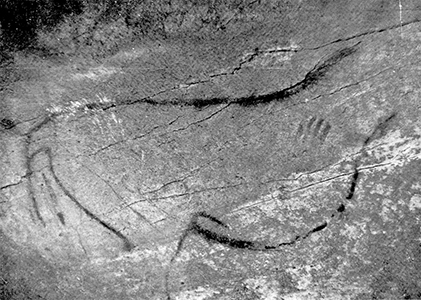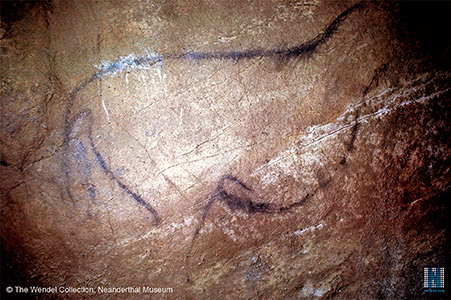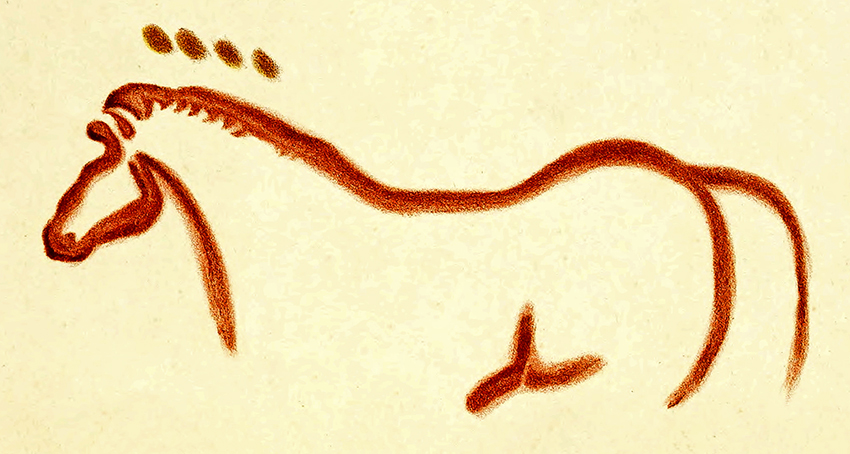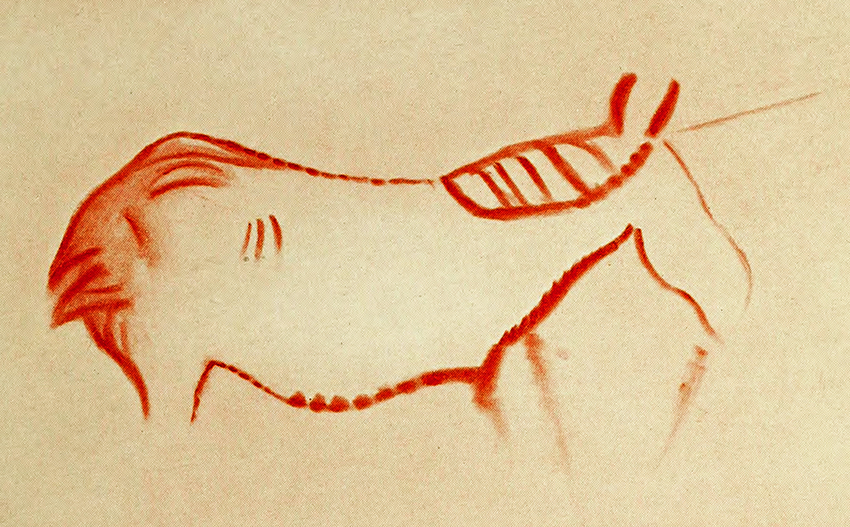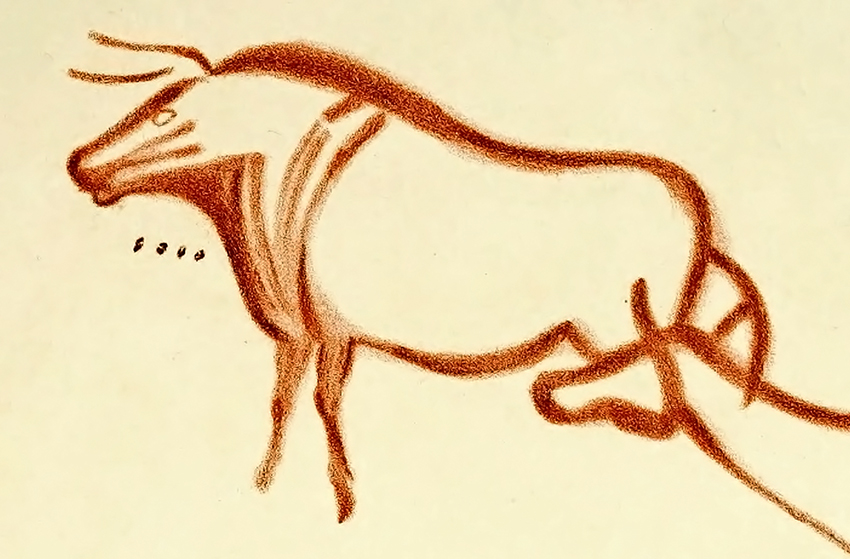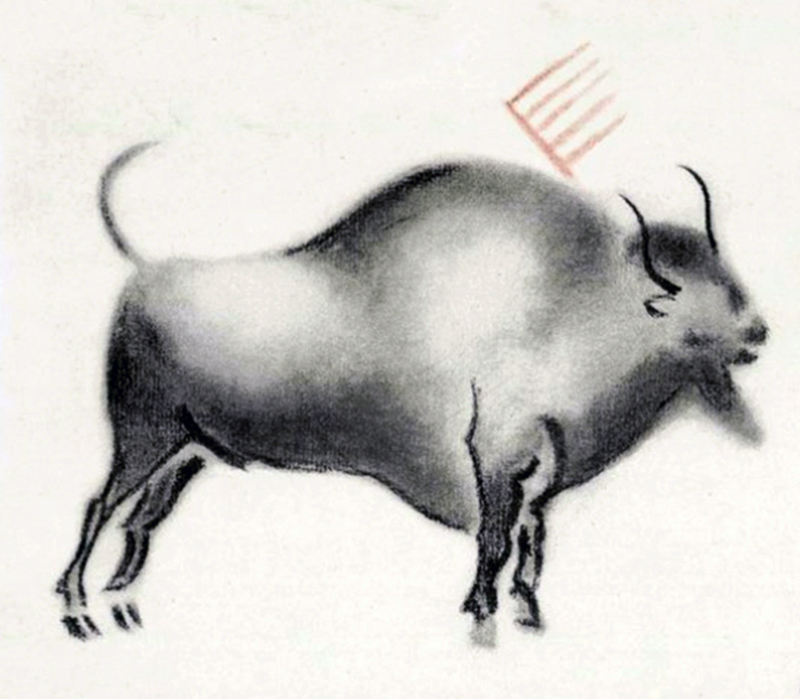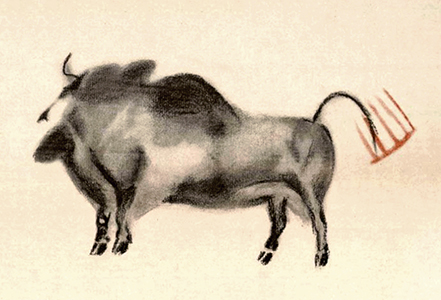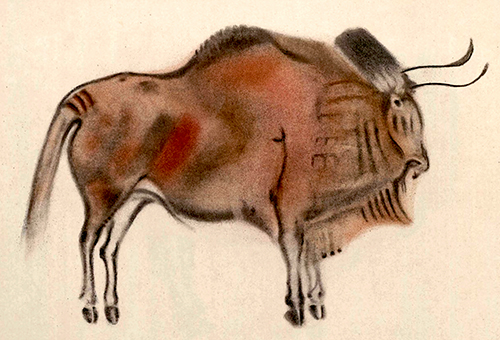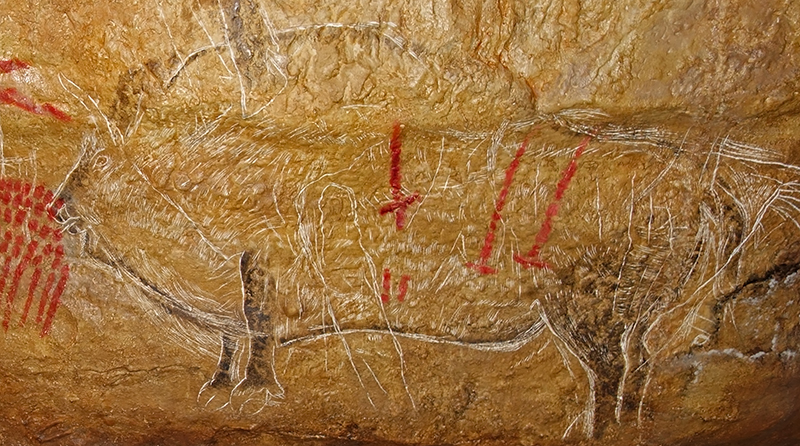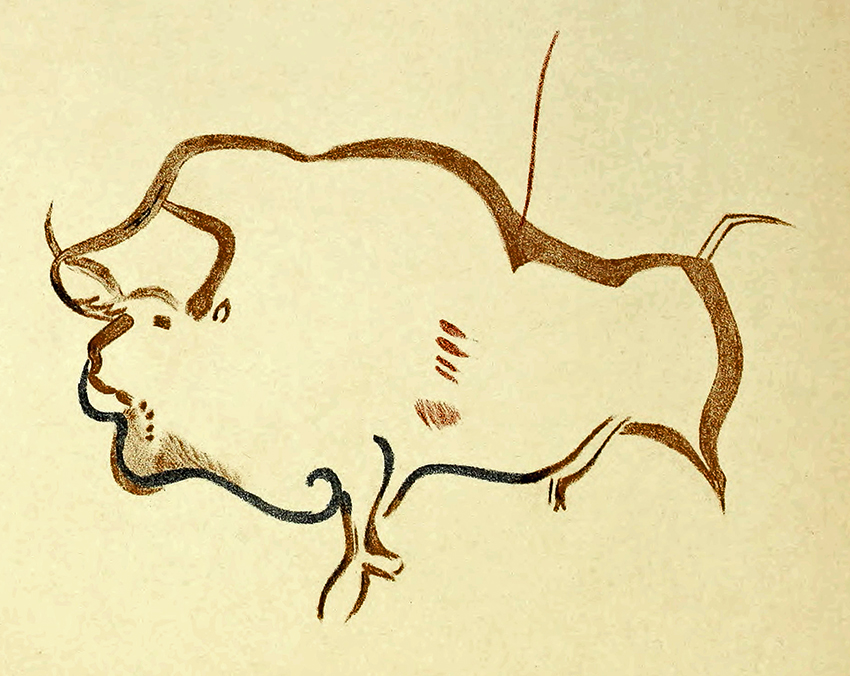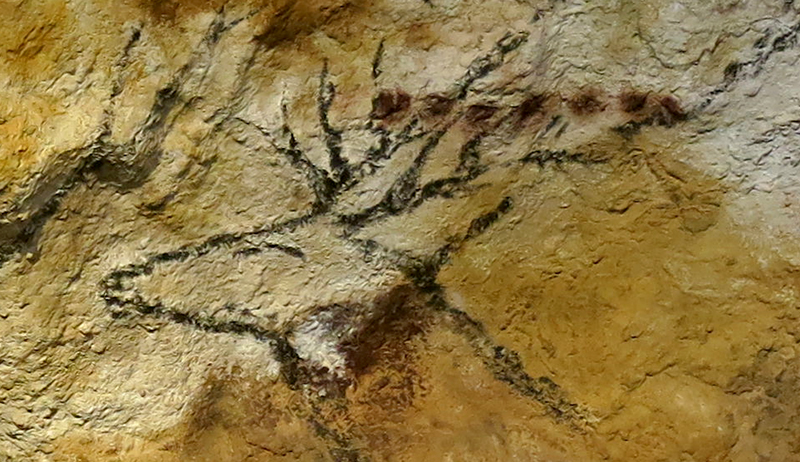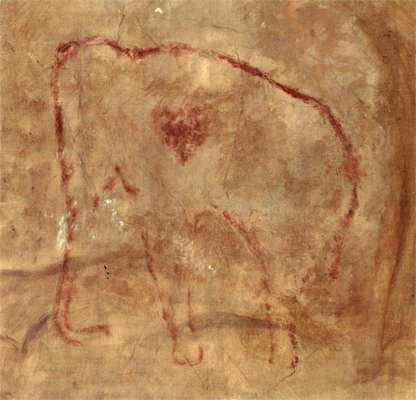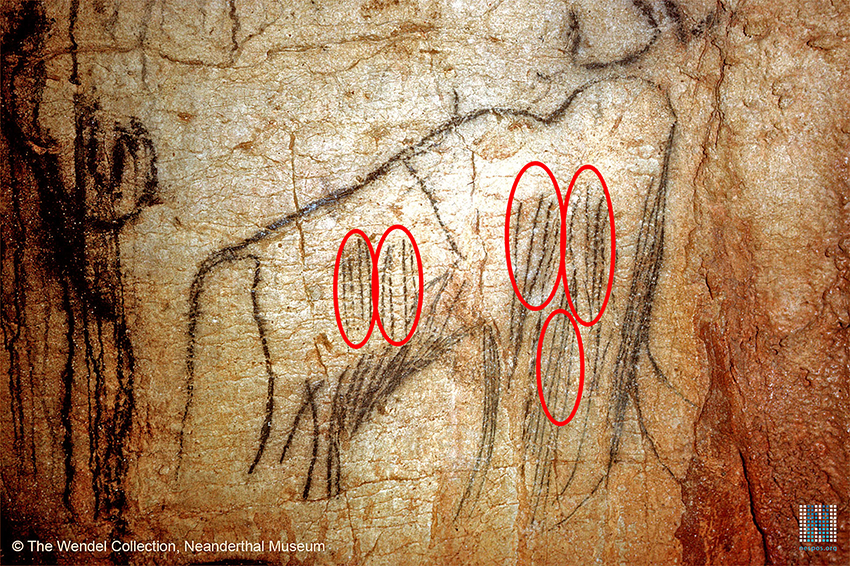Back to Don's Maps
 Back to Archaeological Sites
Back to Archaeological Sites
Dots and Lines in Palaeolithic Cave Art
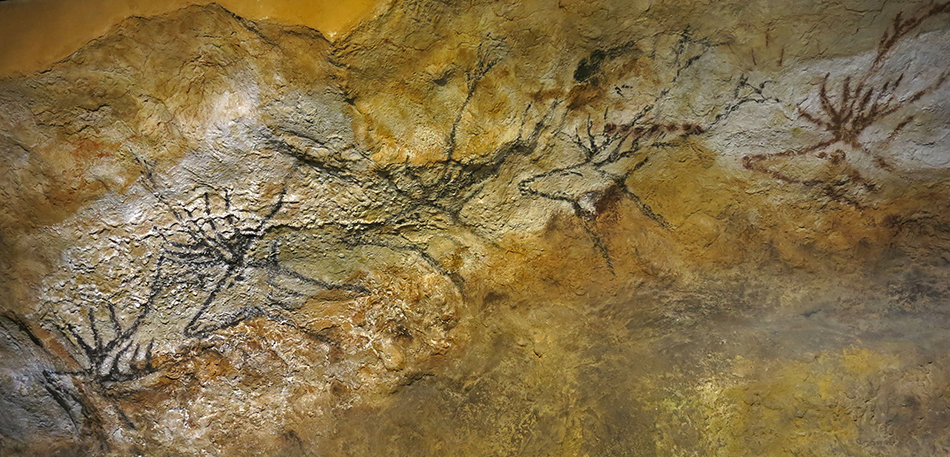
Swimming Stags in the Nave, Lascaux
Photo: Don Hitchcock 2015
Source: Facsimile, Musée d'Aquitaine à Bordeaux
Dots and lines are the most ubiquitous abstract symbols in Palaeolithic art, whether on the walls of caves or on suitable pieces of bone and ivory.
Many researchers have noted the occurrence of these symbols. Here I have put together some of the best examples.
The evidence presented below shows that where the evidence exists and the data is sufficient, there is no correlation between the Taxon and the number of dots or lines. That is:
• Horses have numbers of dots and lines which are across the range of 1, 2, 3, 4, 5, and 6.
• Aurochs (early cattle) have numbers of dots and lines which include 2, 3, 4, 6, 7, 18, and many.
• Bison have numbers of dots and lines which are across the range of 1, 2, 3, 4, and 5.
• Other taxons have limited numbers of examples of such dots and lines, though it should be noted that lions have examples of 4, 5, and 7, and fish have examples of 3, 5, and 7.
Dots occur in almost 45 percent of all French rock shelters. Its main groupings are in the Ardeche, the Dordogne/Lot region and in the French Pyrenees. Half the caves containing dots are Magdalenian, although dots were also painted during the Gravettian and Solutrean.Text above adapted from © visual-arts-cork.com
Lines are the simplest abstract marking in French caves, and occur at more than three quarters of all sites across the country.
| Dots and Lines in Palaeolithic Cave Art | ||||
|---|---|---|---|---|
| Animal | Comment | Linked Image | Count | Text and Link |
| Horse |
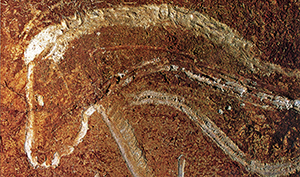 Chauvet Cave is a treasure house of art, and the collection of horse images is unparalleled. |
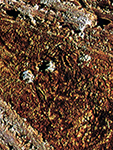
|
3 |
Chauvet Cave The mane of the horse retains the fingerprints of the artist, who demonstrates superb control of the medium. On the neck of the horse may be seen three white dots. See: Chauvet Cave Horse 1 |
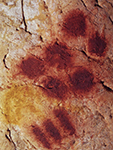
|
1, 3, 6 | Chauvet Cave Two small yellow horse heads, beside six red palm prints and three stroked signs, as well as a single line near the left horse head. See: Chauvet Cave Horse 2 |
||
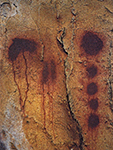
|
2, 5 |
Chauvet Cave Red horse head, below and to the left of the yellow horse heads. Here there are two red lines near the horse, accompanied by five red dots further to the right. These horse heads and signs are in a small alcove, above a flat floor. See: Chauvet Cave Horse 3 |
||
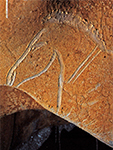
|
2 |
Chauvet Cave Engraved horse, left profile. It is on an overhang close to the owl. Note the two lines at the shoulder and the duckbill muzzle. This horse has been engraved in clay which sometimes forms a thin layer on the walls of caves. In this case, there is a thin panel attached to the roof which the artist has used to advantage, using the curve at the bottom of the panel as the abdomen of the horse. The horse has been drawn with swift, sure strokes, with no hesitation or false starts, the mark of a talented artist. See: Chauvet Cave Horse 4 |
||
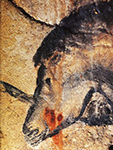
|
4 |
Chauvet Cave Close up of one of the horses from the Alcove of the Lions, with a red stain on the jaw, made up of four dots in red ochre. See: Chauvet Cave Horse 5 |
||
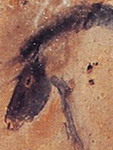
|
2, 3 |
Chauvet Cave This is an exquisitely realised horse, at the centre of the Big Panel of the End Chamber, at the back of a niche. Close examination shows that there are two relatively large dots on the neck of the horse, and three relatively small dots immediately above these. See: Chauvet Cave Horse 6 |
||
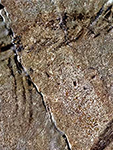
|
3 |
Niaux Cave Only the fore part of this horse is shown, but there are three lines shown on the shoulder. See: Niaux Cave Horse 7 |
||

|
5, 2 |
Altamira, Plate IX Red Horse shown from the right. Five lines and two dots are painted on the shoulder and chest of this horse. See: Altamira Cave Horse 8 |
||
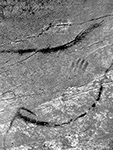
|
4 |
Bedeilhac Cave Large drawing of a horse in black in the Galerie Mandement, with four lines on the shoulder, possibly from a right hand dipped in paint. It is known as 'the pregnant mare'. See: Bedeilhac Horse 9 |
||
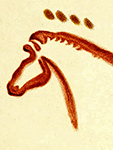
|
4 |
Cueva de La Pasiega Horse with four elongated dots above the head. See: La Pasiega Horse 10 |
||

|
3 |
Cueva de La Pasiega Horse with three lines on the point of the hip. See: La Pasiega Horse 11 |
||
Horse data 
|
||||
| Aurochs |
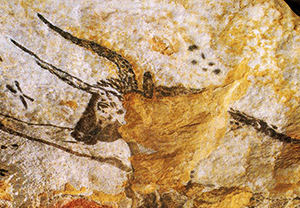 The Hall of the Bulls, Lascaux, is one of the greatest artistic achievements ever created. |
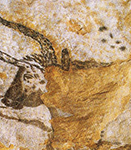
|
7 |
Lascaux Cave The fifth Bull in the Hall of the Bulls has seven black dots associated with it. See: Aurochs 1 |
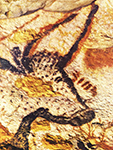
|
2, 3 | Lascaux Cave
Note the curious sign above the snout of this aurochs which might in our symbols be expressed as an s, three lines, and another, different s. Since the symbols at each end of the three lines are different, and, as far as I know, unique, it is tempting to consider that this may possibly be the artist's signature. Or not. However we may count this as three lines for this aurochs bull, together with two unique signs. See: Aurochs 2 |
||

|
6 | Lascaux Cave This aurochs shows six spots on its face around the eye. See: Aurochs 3 |
||
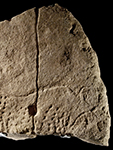
|
many |
Engraving of a bovid from Abri Blanchard, discovered in 2012 by Randall White and his team, estimated to be 38 000 years old. The outline of the bovid includes many small cupules. See: Aurochs 4 |
||
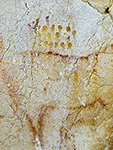
|
~18 |
Grotte de la Tête-du-Lion. Bovid and two heads of Ibex painted in red. Circa 18 dotted signs in a quadrangular pattern. This is almost certainly an aurochs, rather than a bison, judging by the shape and length of the horns and the shape of the shoulders. See: Aurochs 5 |
||
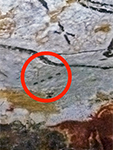
|
4 |
Lascaux Cave Aurochs showing four short lines on the body of the beast. See: Aurochs 6 |
||
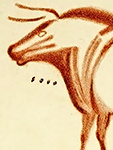
|
4 |
Cueva de La Pasiega This is almost certainly an aurochs, rather than a bison, judging by the shape and length of the horns and the shape of the shoulders. Four dots are associated with this bovid. See: Aurochs 7 |
||
Aurochs data 
|
||||
| Bison |
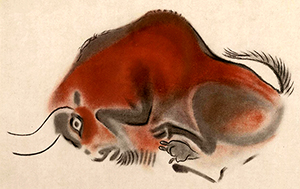 Female bison hunched as though to spring, by Breuil. The artists of Altamira used charcoal and ochre or haematite to create the images, often diluting these pigments to produce variations in intensity and creating an impression of chiaroscuro. They also exploited the natural contours in the cave walls to give their subjects a three-dimensional effect. The Polychrome Ceiling is the most impressive feature of the cave, depicting a herd of extinct Steppe Bison ( Bison priscus ) in different poses, two horses, a large doe, and possibly a wild boar. Photo: Cartailhac et Breuil (1906) Text: Wikipedia |
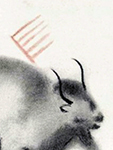
|
5 |
Altamira Small bellowing bison painted in black, including a red pectiform sign (a comb or stylised hand) with five lines. See: Bison 1 |
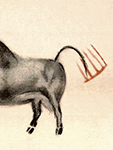
|
5 |
Altamira Small bison painted in black, including a red pectiform sign (a comb or stylised hand) with five lines. See: Bison 2 |
||
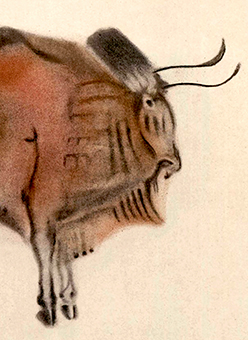
|
2, 5 groups of 3 |
Altamira There are a number of groups of three lines drawn on this bison. By referring to the complete image, we can see that there are three lines drawn at the base of the tail, three on the head below the eye, three close by on the shoulder, and a group of three combs of three, each looking like the capital letter E on its side, though only two of these are very clear. A case could be made that there are a group of either five or six lines on the 'beard' of the bison. See: Bison 3 |
||
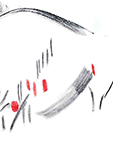
|
1, 3, 1 |
Bedeilhac Cave Large bison in black, with some red modelling. I identify the red marks from left to right as being in groups of one, three, and one, though other interpretations are possible, such as a group of four and one. See: Bison 4 |
||
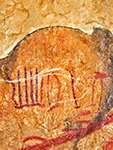
|
5, 1, 2, 1, 2 |
Marsoulas Cave This large polychrome bison has its tail and dorsal line outlined in black, with the head and neck completed in brown and black. On the body of the bison we may see, from left to right, a comb structure in purple of five lines, then a single red line, a double red line, a purple single line, and then a double red line. See: Bison 5 |
||
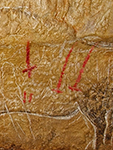
|
1, 2, 2
|
Marsoulas Cave This lower right section displays a well realised portrait of a bison in black, with the piece given extra dimension by scratching through the patina on the rock, by a master artist. On the bison are a single crossed red line, a pair of red lines each crossed at the base, and a pair of smaller red lines. See: Bison 6 |
||
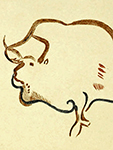
|
4
|
Bison from Cueva de La Pasiega, Plate XXVIII, with four lines on its flank. See: Bison 7 |
||
Bison data 
|
||||
| Red Deer |
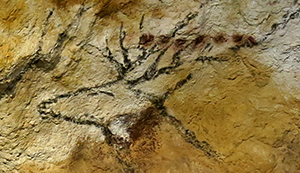 Lascaux Cave has a superb collection of Magdalenian art, including this example from the frieze known as the 'swimming stags'. |
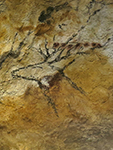
|
7 |
Close examination of the swimming stags in the nave, Lascaux, reveals this instance of seven dots in a row, associated with one of the stags. See: Lascaux Deer 1 |
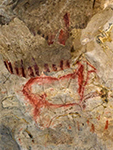
|
10 (5) |
Hind and red marks at Cueva del Pindal. Note that the red lines are on a closely overhanging rock in the field of view, and that the five (?) red lines below the hind may be more associated with it. See: Cueva del Pindal Deer 2 |
||
Red Deer data 
|
||||
| Reindeer |
 Reindeer were a very important resource for many ice age hunters. They supplied meat, skins, bone, antler, and sinews. Photo: adapted from Caselli (1985) |
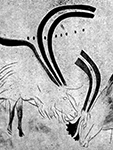
|
8 |
This superb piece of art from Font de Gaume shows a male reindeer licking the forehead of a kneeling female reindeer, with eight blue-black dots shown.
See: Reindeer 1 |
| Megaloceros |
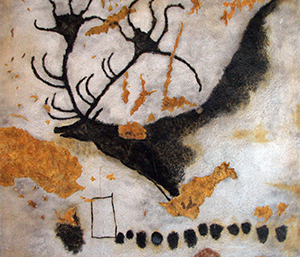 Megaloceros in the Axial Gallery of Lascaux |
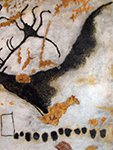
|
12 |
Megaloceros in the Axial Gallery, with twelve black dots. This is also known as the black stag.
See: Megaloceros 1 |
| Wooly Rhinoceros |
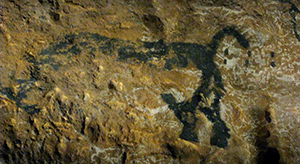 The main scene in the well or shaft of Lascaux includes a disembowelled bison, a man with a bird's head who appears to have been felled by the bison, a spear, and a bird on a pole. Beside the panel of the man killed by the bison, is this apparently unrelated image of a wooly rhinoceros, which is a superbly realised portrait of a dangerous animal. |
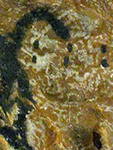
|
6 |
The six black dots are of unknown significance.
See: Wooly Rhinoceros 1 |
| Bear |
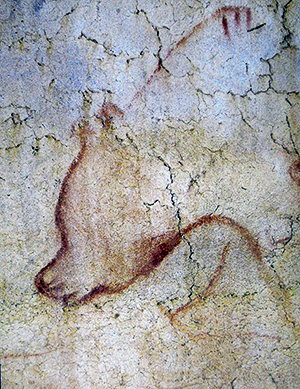 Red bear, on the wall in the Cactus Gallery in Chauvet Cave. |
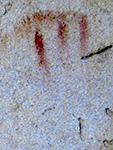
|
3 |
Chauvet Cave Red bear, 80 cm wide, on the wall in the Cactus Gallery. The bear has three red lines at the shoulder. See: Bear 1 |
| Cave Lion |
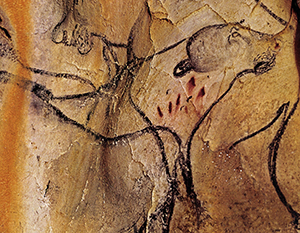 The lions in this image are the ones which give the Alcove of Lions its name. A cave lion - an extinct maneless species - seems to sniff the hindquarters of a crouched and snarling companion. The two may represent a mating pair. |
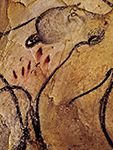
|
5 |
Chauvet Cave Five lines in red ochre on the neck of a Cave lion, smudged by moisture running down the wall. See: Lion 1 |

|
4 |
Isturitz A cave lion carved in reindeer antler, from Isturitz, Basses Pyrenees. The holes and the arrows carved in this beautifully polished sculpture have been interpreted as magical symbols. See: Lion 2 |
||
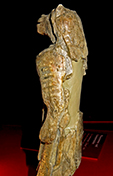
|
7 |
This Löwenmensch figurine, half lion, half man, is one of the oldest-known examples of an artistic representation. An example of zoomorphic art, it was carved out of mammoth ivory using a flint stone knife. Seven parallel, transverse, carved gouges are on the left arm.
See: Lion 3 |
||
Cave Lion data 
|
||||
| Fish |
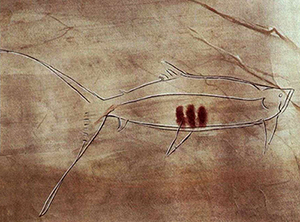 Fish are rarely shown in cave paintings and engravings. This one appears, strangely, to be a deep sea type. |
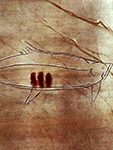
|
3 |
Cueva del Pindal Engraving showing a fish with three red spots inside. See: Fish 1 |
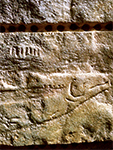
|
7, 5 |
Abri du Poisson Salmon closeup. There are seven lines engraved above the fish, and five holes drilled in the body of the fish. See: Fish 2 |
||
Fish data 
|
||||
| Mammoth |
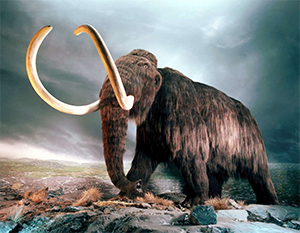 A superb mammoth displayed in the Royal British Columbian Museum in Victoria, B.C. Photo: http://www.liveinternet.ru/users/3707322/post147516947/ |
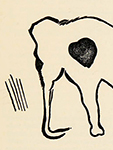
|
1, 5 |
Cueva del Pindal Mammoth with a single spot resembling a heart, as well as five lines associated with the mammoth. See: Mammoth 1 |
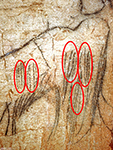
|
5 x 4 |
Pech Merle Mammoth with five groups of four lines delineated on the flanks of the mammoth. See: Mammoth 2 |
||
Mammoth data 
|
||||
| Oil Lamp |
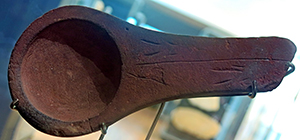 An oil lamp (a deer fat lamp), found in the sediments in the floor of the Shaft at Lascaux cave in Montignac, Dordogne, Aquitaine, France. Magdalenian culture, 17 000 BP. |
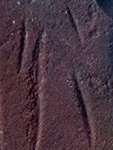
|
4, 4 |
Here we may see two groups of four lines each on the handle of the lamp.
See: Oil Lamp 1 |
Horse 1
Chauvet Cave. The mane of the horse retains the fingerprints of the artist, who demonstrates superb control of the medium.
On the neck of the horse may be seen three white dots.
Photo: National Geographic August 2001
Horse 2
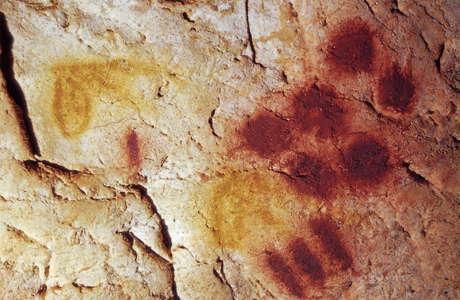
Chauvet Cave.
Two small yellow horse heads, beside six red palm prints and three stroked signs, as well as a single line near the left horse head.
Photo: Clottes (2003)
Horse 3
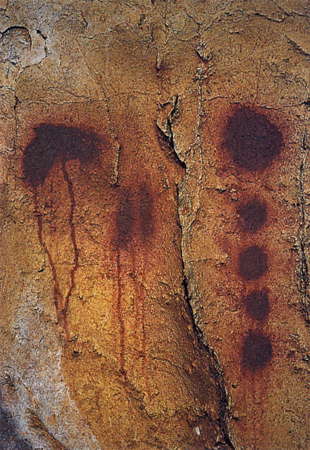
Chauvet Cave.
Red horse head, below and to the left of the yellow horse heads.
Here there are two red lines near the horse, accompanied by five red dots further to the right.
These horse heads and signs are in a small alcove, above a flat floor.
Photo: Chauvet, Deschamps et Hillaire (1996)
Horse 4
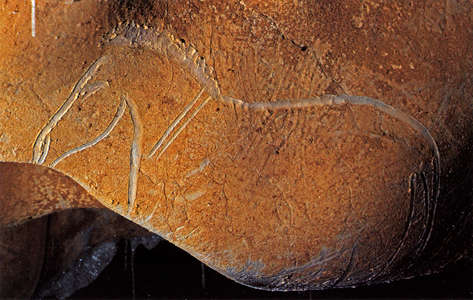
Chauvet Cave.
Engraved horse, left profile. It is on an overhang close to the owl. Note the two lines at the shoulder and the duckbill muzzle.
This horse has been engraved in clay which sometimes forms a thin layer on the walls of caves. In this case, there is a thin panel attached to the roof which the artist has used to advantage, using the curve at the bottom of the panel as the abdomen of the horse. The horse has been drawn with swift, sure strokes, with no hesitation or false starts, the mark of a talented artist.
Careful inspection reveals much older 'macaroni' marks on the panel, over which the horse has been drawn. Macaroni marks of this nature have sometimes been attributed to children.
Photo and text: Chauvet, Deschamps et Hillaire (1996)
Extra text: http://www.istmira.com/foto-i-video-pervobytnoe-obschestvo/3924-iskusstvo-predystorii-pervobytnost-2.html
Horse 5
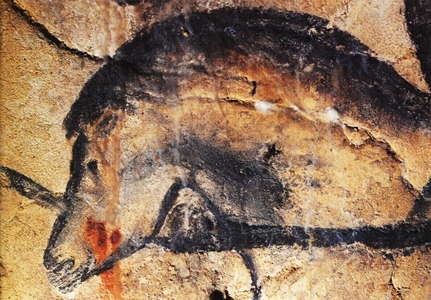
Chauvet Cave.
Close up of one of the horses from the Alcove of the Lions, with a red stain on the jaw, made up of four dots in red ochre.
Photo: http://www.istmira.com/foto-i-video-pervobytnoe-obschestvo/3924-iskusstvo-predystorii-pervobytnost-2.html
Horse 6
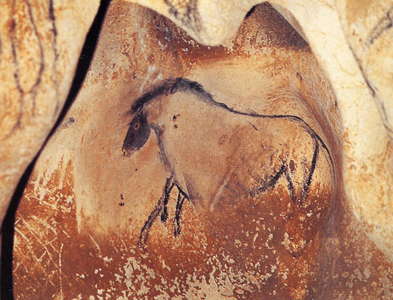
Chauvet Cave.
This is an exquisitely realised horse, at the centre of the Big Panel of the End Chamber, at the back of a niche.
Close examination shows that there are two relatively large dots on the neck of the horse, and three relatively small dots immediately above these.
The smudging, whether by accident or design, of the head and mane towards the front of the horse lends an ethereal quality to the image.
Note also that in this portrait, the artist has consciously decided to give the horse a dark head. Obviously there were differences even at that time in the markings of individual horses.
Photo: http://www.istmira.com/foto-i-video-pervobytnoe-obschestvo/3924-iskusstvo-predystorii-pervobytnost-2.html
Horse 7
Niaux, Salon Noir
Horse showing the stiff mane and beard of the horses of the time, only the fore part of the horse is shown.
The head is particularly well sketched.
There are three lines shown on the shoulder of the horse.
Photo: Heinrich Wendel (© The Wendel Collection, Neanderthal Museum)
Horse 8
Altamira, Plate IX
Red Horse shown from the right.
Five lines and two dots are painted on the shoulder and chest of this horse.
Photo: Cartailhac et Breuil (1906)
Photo: Cartailhac et Breuil (1906)
Horse 9
Bedeilhac Cave
Large drawing of a horse in black in the Galerie Mandement, with four lines on the shoulder, possibly from a right hand dipped in paint. It is known as 'the pregnant mare'.
Photo (left): after Robert (1946), in Beltrán et al. (1967)
Photo (right): Heinrich Wendel (© The Wendel Collection, Neanderthal Museum)
Horse 10
Cueva de La Pasiega
Four dots are associated with this horse.
Photo: Plate II, Breuil et al. (1913)
Horse 11
Cueva de La Pasiega
Three lines have been painted on the point of the hip.
Photo: Plate XIX, Breuil et al. (1913)
Aurochs 1
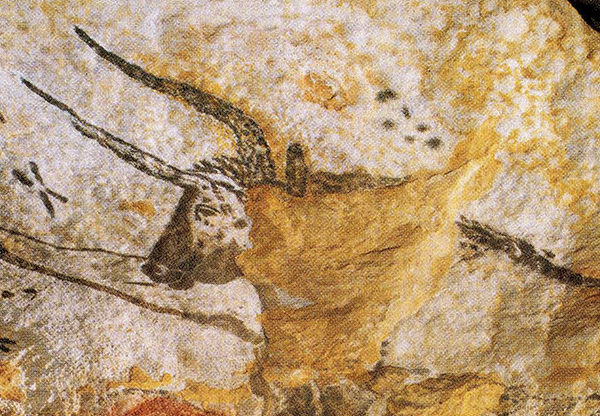
Fifth Bull in the Hall of the Bulls, Lascaux, with seven dots shown.
Photo: Brochure, Lascaux Révélé été 2008 Montignac (Dordogne)
Aurochs 2

Head of a bull Aurochs in the Hall of Bulls, Lascaux
Note the curious sign above the snout which might in our symbols be expressed as an s, three lines, and another, different s.
Photo: http://www.istmira.com/foto-i-video-pervobytnoe-obschestvo/3923-iskusstvo-predystorii-pervobytnost-1.html
Aurochs 3
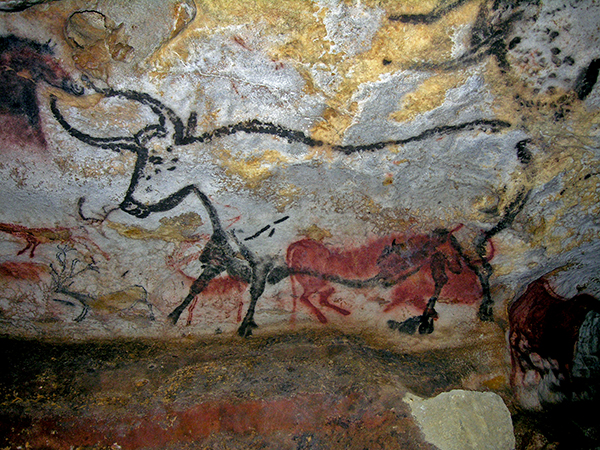
Detail of Hall of Bulls, Lascaux II (replica of the original cave, which is closed to the public), original cave: circa 18 000 – 16 000 BP.
Photo: Possibly Francesco Bandarin, CC BY-SA 3.0
Proximal source for photo and text: Looney (2015)
Aurochs 4

Engraving of a bovid from Abri Blanchard, discovered in 2012 by Randall White and his team, estimated to be 38 000 years old.
The outline of the bovid includes many small cupules.
Photo: © Musée national de Préhistoire collections, Bourrillon, White et al. (2017)
Aurochs 5
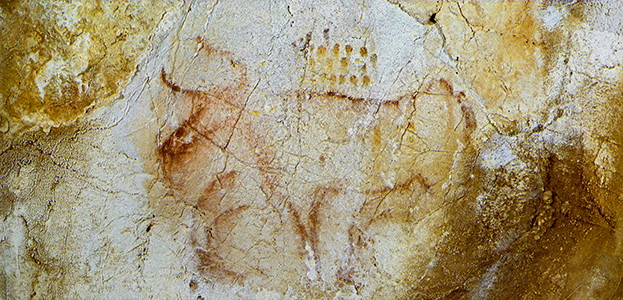
Grotte de la Tête-du-Lion.
Bovid and two heads of Ibex painted in red. Dotted signs in a quadrangular pattern.
This is almost certainly an aurochs, rather than a bison, judging by the shape and length of the horns and the shape of the shoulders.
Photo: G. Taupenas
Source: Leroi-Gourhan (1984)
Aurochs 6
Lascaux Cave
Aurochs in the Hall of the Bulls. Note the four short lines on the body of the aurochs.
As always, click on this thumbnail to see the full size image, in this case without the red circle.
Photo: JoJan
Permission: Creative Commons Attribution 4.0 International license, via Wikimedia.
Aurochs 7
Cueva de La Pasiega
Probably an aurochs by the shape and length of the horns and the shoulders shape, rather than a bison.
Four dots are associated with this bovid.
Photo: Plate XVIII, Breuil et al. (1913)
Bison 1
Plate VII
Small bison painted in black, modelled on le grand plafond, and a red pectiform sign (a comb or stylised hand).
Dimensions of the bison, from the base of the tail to the nostrils: 90 cm.
Shown is a bison bellowing. Very faint engraving marks on the nape of the neck, stronger on the dewlap.
Photo and text: Cartailhac et Breuil (1906)
Bison 2
Plate VII
Small bison painted in black, modelled on le grand plafond, and a red pectiform sign (a comb or stylised hand).
Photo and text: Cartailhac et Breuil (1906)
Bison 3
Plate XXII
This is labelled by Cartailhac et Breuil (1906) as a standing Bison, but the arrangement of the hooves shows that it was painted from a kill lying on the ground.
It is further described as being very shaggy.
There are a number of groups of three lines drawn on the bison.
Photo and text: Cartailhac et Breuil (1906)
Bison 4
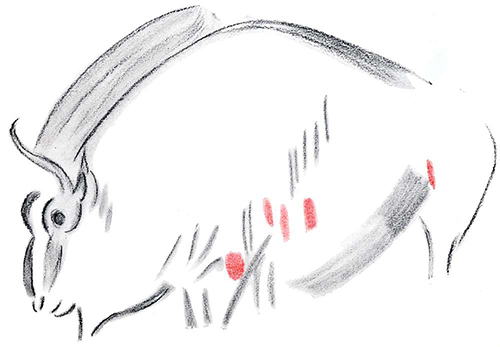
Large bison in black, with some red modelling.
Turned to the left is a large black bison, modelling incomplete, 240 cm long; only the forequarters and half of the body are well preserved. His side is marked with four red vertical bars. On top of his kidneys I noticed a rocky protuberance, a natural relief accented by a small stroke.
Photo and translated text: after Breuil et al. (1925), in Beltrán et al. (1967)
Bison 5
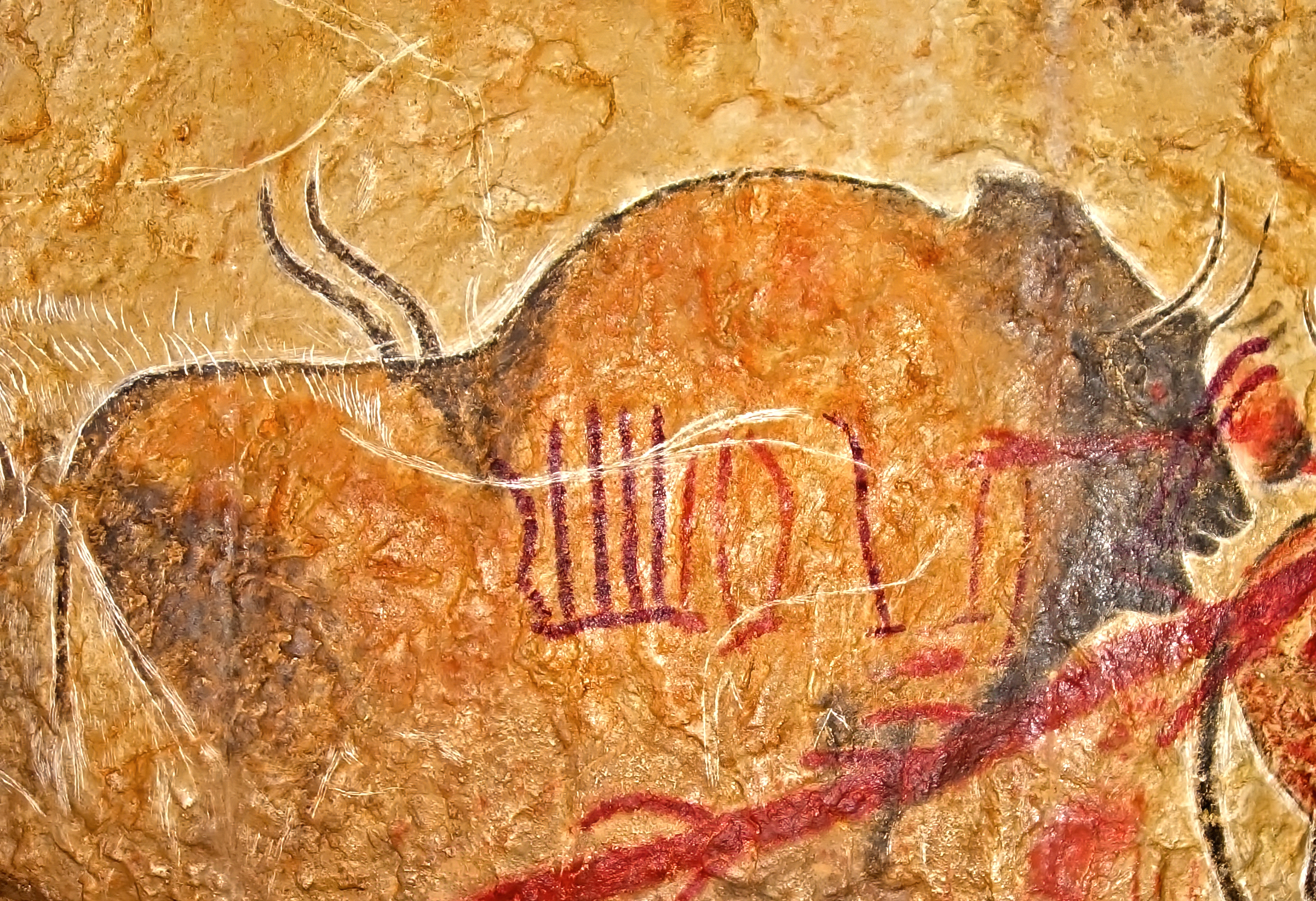
This large polychrome bison has its tail and dorsal line outlined in black, with the head and neck completed in brown and black. It is overlain by various linear symbols in red, as well as the ubiquitous thick red meandering line which is so much a feature of this panel, with paired red 'leaves' in this instance at regular intervals.
On the body of the bison we may see, from left to right, a comb structure in purple of five lines, then a single red line, a double red line, a purple single line, and then a double red line.
Photo: Ralph Frenken 2019
Text: Don Hitchcock
Source: Le Parc de la Préhistoire de Tarascon-sur-Ariège
Bison 6
This lower right section displays a well realised portrait of a bison in black, with the piece given extra dimension by scratching through the patina on the rock, by a master artist.
On the bison are a single crossed red line, a pair of red lines each crossed at the base, and a pair of smaller red lines.
Photo: Ralph Frenken 2019
Text: Don Hitchcock
Source: Le Parc de la Préhistoire de Tarascon-sur-Ariège
Bison 7
Bison with four lines on its flank, from Cueva de La Pasiega.
Photo: Plate XXVIII, Breuil et al. (1913)
Red Deer 1
Close examination of the swimming stags in the nave, Lascaux, reveals this instance of seven dots in a row.
Photo: Don Hitchcock 2015
Source: Facsimile, Musée d'Aquitaine à Bordeaux
Red Deer 2
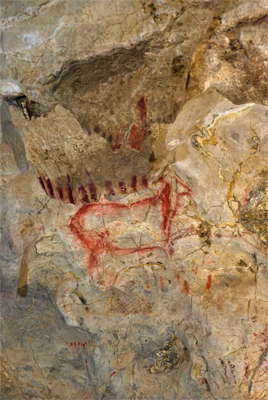
Hind and red marks at Cueva del Pindal.
Photo: http://mensulaediciones.wordpress.com/category/patrimonio-mundial/page/2/, originally from Pumariega (2011)
Reindeer 1
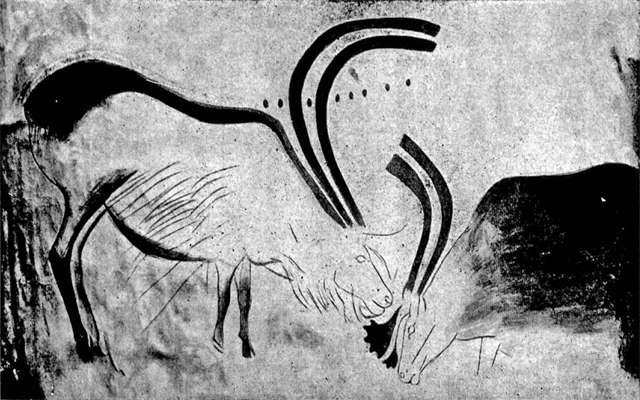
This combination of engraving, with black lines delineating the shape, and with flat black and red colours inside the bounding lines, is very evident in the remarkable group of two facing reindeer which we show here. These animals were carefully delineated by a sharp line only for the heads. In addition, the reindeer on the left has a clear scraping of the rock on the edge of the back, delimited within by a red line.
This in turn is surrounded by a broad black deteriorated band which depicts the hindquarters of the animal. The horns are black and pass through a line of eight bluish-black spots.
The upper antlers of the other reindeer are painted in red pigment, the antlers at the front are flat and fingered, so characteristic of the reindeer, and are painted in black.
The trunk is smeared with a degraded red ochre tint. The group measures 210 cm in length, and is 130cm high.
Photo and text: Capitan et Breuil 1903
Megaloceros 1
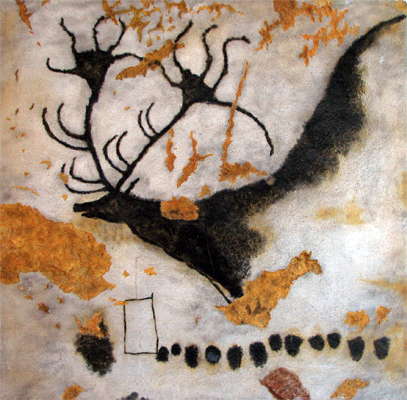
Megaloceros in the Axial Gallery, with twelve black dots. This is also known as the black stag.
Photo: Facsimile, HTO, 22nd May 2009
Permission: Public Domain
Wooly Rhinoceros 1

The main scene in the well or shaft of Lascaux includes a disembowelled bison, a man with a bird's head who appears to have been felled by the bison, a spear, and a bird on a pole. Beside the panel of the man killed by the bison, is this apparently unrelated image of a wooly rhinoceros, which is a superbly realised portrait of a dangerous animal. The six black dots are of unknown significance.
Photo: Don Hitchcock 2008
Source: Display at Lascaux Révélée
Bear 1

Chauvet Cave
Red bear, 80 cm wide, on the wall in the Cactus Gallery.
The bear has three red lines at the shoulder.
Photo: Clottes (2003)
Lion 1

Chauvet Cave
The lions in this image are the ones which give the Alcove of Lions its name.
A cave lion - an extinct maneless species - seems to sniff the hindquarters of a crouched and snarling companion. The two may represent a mating pair.
Seventy-two felines appear on Chauvet's walls, along with portraits of more than a dozen other species - 420 animal figures in all - that shared the Palaeolithic landscape with Homo sapiens.
Photo and text: Jean Clottes © National Geographic, August 2001
Lion 2
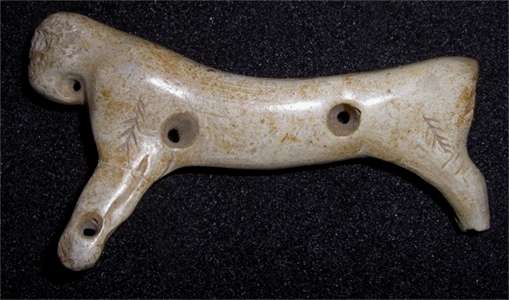
A cave lion carved in reindeer antler, from Isturitz, Basses Pyrenees. The holes and the arrows carved in this beautifully polished sculpture have been interpreted as magical symbols.
Photo: http://www.i-s-c-a.com/show-cave/38-grottes-d-isturitz-et-oxocelhaya
Lion 3
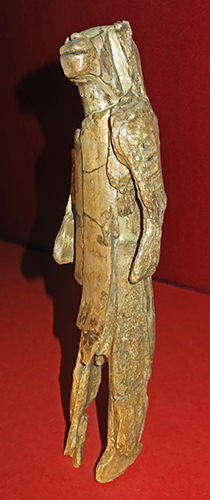
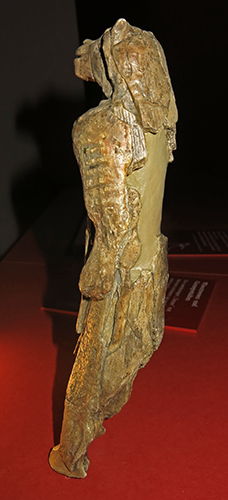
The Löwenmensch figurine, also called the Lion-man of Hohlenstein-Stadel, is a prehistoric ivory sculpture discovered in Hohlenstein-Stadel, a German cave in 1939. The German name, Löwenmensch, meaning 'lion-person' or 'lion-human', is used most frequently because it was discovered and is exhibited in Germany.
Determined by carbon dating of the layer in which it was found to be between 35,000 and 41,000 years old, it is one of the oldest-known examples of an artistic representation and the oldest confirmed statue ever discovered. Its age associates it with the archaeological Aurignacian culture of the Upper Paleolithic. An example of zoomorphic art, it was carved out of mammoth ivory using a flint stone knife. Seven parallel, transverse, carved gouges are on the left arm.
After several reconstructions that have incorporated newly found fragments, the figurine stands 31.1 cm (12.2 in) tall, 5.6 cm (2.2 in) wide, and 5.9 cm (2.3 in) thick. It currently is displayed in the Museum Ulm, in the town of Ulm.
Photo: Don Hitchcock 2015
Source: Facsimile, Monrepos Archäologisches Forschungszentrum und Museum, Neuwied, Germany
Fish 1
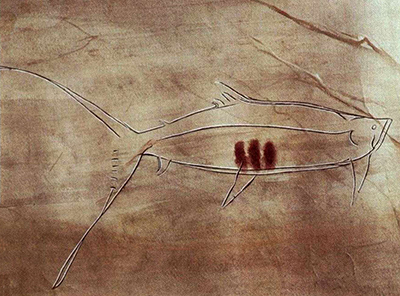
Engraving showing a fish with three red spots inside.
Bahn et al. (1997) say that it has the fins and tail of a tuna, and the body of a salmonid (salmon or trout).
(the tail appears to be of a deep sea fish to me, the closest I can come to identifying it is some sort of Atlantic Tuna. However, there are coastal tunas, Euthynnus sp.
If it is a hybrid representation, the fins of the body and the body itself are much closer to a salmonid than a tuna, though the tail is tuna-like, perhaps exaggerated in length and spread. My hypothesis is that the artist was very familiar with trout and/or salmon, but had seen a tuna, was impressed by the tail, and did the engraving from memory, exaggerating the tail. In any case, it is a superb artistic effort, demonstrating real talent. There is not a wasted line in the whole thing - Don )
Photo: Berenguer (1994)
Fish 2
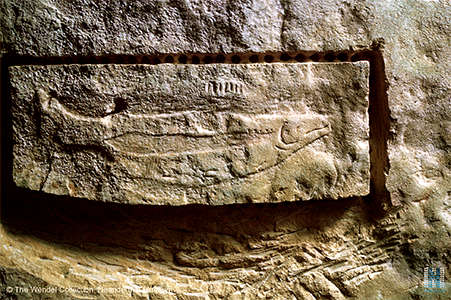
Abri du Poisson salmon closeup. There are seven lines engraved above the fish, and five holes drilled in the body of the fish.
There was an attempt made once to steal this sculpture, and the thieves were disturbed at the point where they had put a series of holes around the sculpture ready to undercut it.
This photograph of the carving in situ shows the drill holes and carving which was done preparatory to the attempted removal of the engraving.
When I visited the cave, it seemed to me that the thieves would have tried to crack the block off the ceiling by chiselling from the lower part of the carving, since there had been a lot of work done to gain access to that part of the sculpture.
There would have been a significant risk of destroying the carving completely if the work had proceeded any further.
Photo: Heinrich Wendel (© The Wendel Collection, Neanderthal Museum)
Mammoth 1
Mammoth painted in red with what appears to be a heart, painted in the same colour, at the left shoulder, as well as a group of five lines associated with the mammoth.
Photo (left): Berenguer (1994)
Sketch (right): Abbé Breuil, proximal source Broderick (1963)
Mammoth 2
This image shows a Mammoth from the walls of Pech Merle. It is notable for the long hair the artist has given it, which serves to give the image its character.
In addition, there are at least five groups of four lines on the flanks of the mammoth.
To see the original image without the red ellipses, click on the thumbnail, when the full size image will appear.
Photo: Heinrich Wendel (© The Wendel Collection, Neanderthal Museum)
Lamp 1
An oil lamp (a deer fat lamp), found in the sediments in the floor of the Shaft at Lascaux cave in Montignac, Dordogne, Aquitaine, France. Magdalenian culture, 17 000 BP. It can be viewed in the National Prehistory Museum in Les Eyzies-de-Tayac.
Here we may see two groups of four lines on the handle of the lamp.
The red sandstone lamp was found by Abbé André Glory at Lascaux. André Leroi-Gourhan, said in 1982 that Abbé Glory was the man who best knew Lascaux.
Photo: Don Hitchcock 2014
Source: Original on display at Le Musée National de Préhistoire, Les Eyzies-de-Tayac
Comments on the dots meaning mating etc concept: https://www.livescience.com/ice-age-cave-art-proto-writing-claim Early humans in Europe were hunter-gatherers who ate a lot of meat from species such as horses, deer and bison. When those animals came together seasonally in herds, they would have been vulnerable to slaughter by humans. "It follows that knowledge of the timing of migrations, mating and birthing would be a central concern to Upper Paleolithic behaviour," study first author Bennett Bacon (opens in new tab), an independent researcher and furniture conservator based in London, and colleagues wrote in their study. Looking at the total number of marks — either dots or lines — found in sequences across hundreds of caves, the researchers discovered that none of the series contained more than 13 marks, consistent with the 13 lunar months in each year. "We hypothesize that sequences are conveying information about their associated animal taxa in units of months," they wrote, noting that spring, "with its obvious signals of the end of winter and corresponding faunal migrations to breeding grounds, would have provided an obvious, if regionally differing, point of origin for the lunar calendar."
References
- Bacon, B., Khatiri, A., Palmer, J., Freeth, T., Pettitt, P., Kentridge, R., 2023: An Upper Palaeolithic Proto-writing System and Phenological Calendar, Cambridge Archaeological Journal,1-19. doi:10.1017/S0959774322000415
- Beltrán, A., Robert, R., Gailli R., 1967: La Cueva de Bédeilhac, Zaragoza 1967
- Berenguer, M., 1994: Prehistoric cave art in Northern Spain, Asturias,Cuidad de Mexico: Frente de Afirmacion Hispanista.
- Bourrillon, R., White, R., et al., 2017: A new Aurignacian engraving from Abri Blanchard, France: Implications for understanding Aurignacian graphic expression in Western and Central Europe, Quaternary International, 2017; DOI: 10.1016/j.quaint.2016.09.063
- Breuil, H., Obermaier, H., Alcalde Del Rio, H., 1913: La Pasiega à Puente-Viesgo (Santander) (Espagne), Imprimerie Artistique Vve A. Chêne, 1913
- Breuil, H., Vidal G., 1925: Découverte de peintures à Bédeilhac. C.R. Acadédemie Inscriptions et Belles-Lettres. Séance du 14 août 1925, p.222
- Broderick, A., 1963: Father of prehistory; the Abbé Henri Breuil: his life and times, New York, Morrow.
- Capitan L., Breuil H., 1903: Les figures peintes à l'époque paléolithique sur les parois de la grotte de Font-de-Gaume (Dordogne), Comptes-rendus des séances de l'Académie des Inscriptions et Belles-Lettres, 47e année, N. 2, 1903. pp. 117-129.
- Cartailhac, É., Breuil H., 1906: La Caverne d'Altamira a Santillane près Santander (Espagne) Imprimerie de Monaco, 1906.
- Caselli, G., 1985: The Everyday Life of an Ice Age Hunter, Macdonald & Co.
- Chauvet J., Deschamps E., Hillaire C., 1996: Chauvet Cave, The Discovery of the World's Oldest Paintings Thames and Hudson, London.
- Clottes J., 2003: Chauvet Cave The Art of Earliest Times, University of Utah Press, Salt Lake City, 2003
- Leroi-Gourhan A., 1984: L'Art des cavernes : Atlas des grottes ornées paléolithiques françaises, Relié – 1 décembre 1984
- Looney M., 2015: Hall of Bulls, Lascaux, Smarthistory, November 19, 2015, accessed January 9, 2023, https://smarthistory.org/hall-of-bulls-lascaux/
- Robert, R., 1946: Fouilles à la grotte de Bédeilhac, Bulletin de la Société préhistorique française, 1946, tome 43, No. 9-12. pp. 322-326
Back to Don's Maps
 Back to Archaeological Sites
Back to Archaeological Sites
